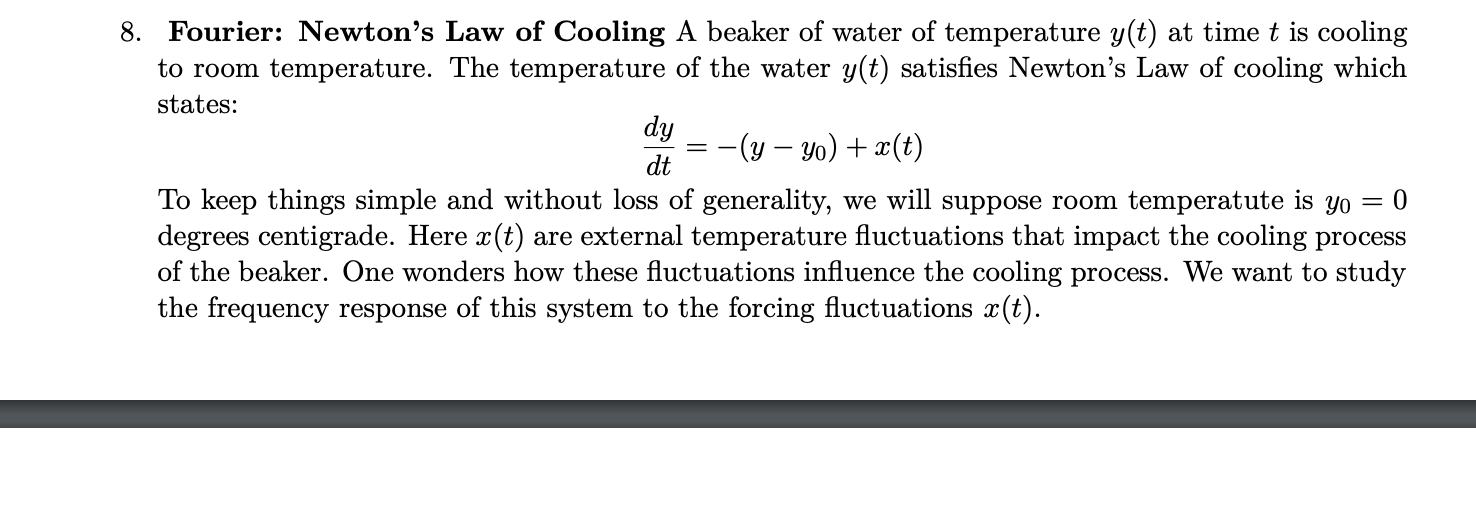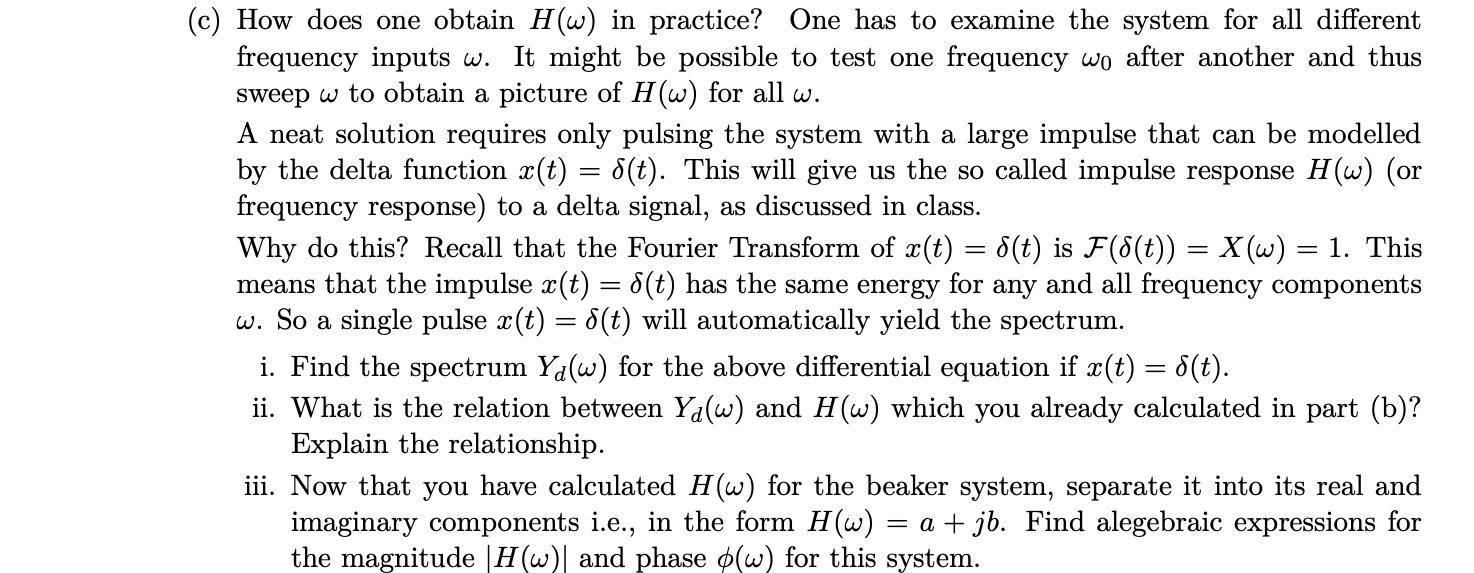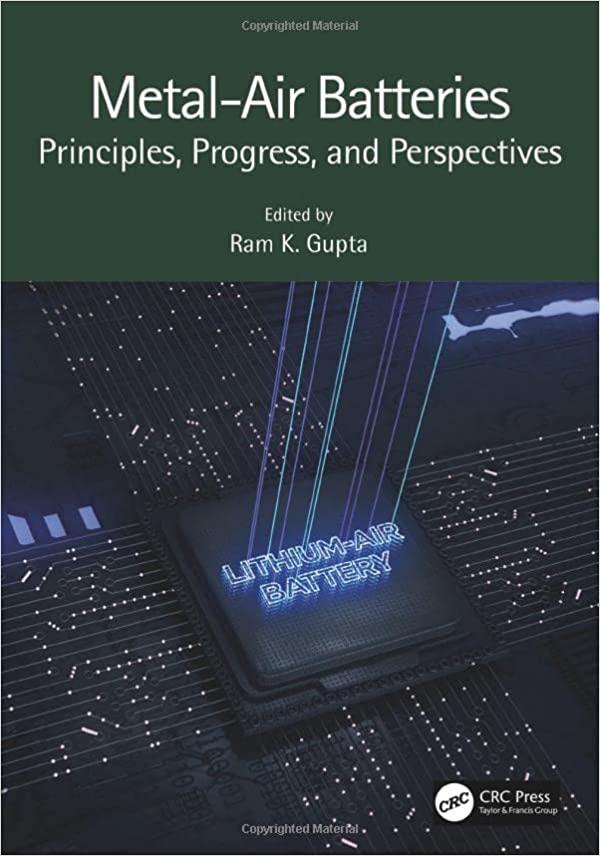Answered step by step
Verified Expert Solution
Question
1 Approved Answer
Fourier: Newton's Law of Cooling A beaker of water of temperature y(t) at time t is cooling to room temperature. The temperature of the water

 Fourier: Newton's Law of Cooling A beaker of water of temperature y(t) at time t is cooling to room temperature. The temperature of the water y(t) satisfies Newton's Law of cooling which states: dtdy=(yy0)+x(t) To keep things simple and without loss of generality, we will suppose room temperatute is y0=0 degrees centigrade. Here x(t) are external temperature fluctuations that impact the cooling process of the beaker. One wonders how these fluctuations influence the cooling process. We want to study the frequency response of this system to the forcing fluctuations x(t). How does one obtain H() in practice? One has to examine the system for all different frequency inputs . It might be possible to test one frequency 0 after another and thus sweep to obtain a picture of H() for all . A neat solution requires only pulsing the system with a large impulse that can be modelled by the delta function x(t)=(t). This will give us the so called impulse response H() (or frequency response) to a delta signal, as discussed in class. Why do this? Recall that the Fourier Transform of x(t)=(t) is F((t))=X()=1. This means that the impulse x(t)=(t) has the same energy for any and all frequency components . So a single pulse x(t)=(t) will automatically yield the spectrum. i. Find the spectrum Yd() for the above differential equation if x(t)=(t). ii. What is the relation between Yd() and H() which you already calculated in part (b)? Explain the relationship. iii. Now that you have calculated H() for the beaker system, separate it into its real and imaginary components i.e., in the form H()=a+jb. Find alegebraic expressions for the magnitude H() and phase () for this system. Fourier: Newton's Law of Cooling A beaker of water of temperature y(t) at time t is cooling to room temperature. The temperature of the water y(t) satisfies Newton's Law of cooling which states: dtdy=(yy0)+x(t) To keep things simple and without loss of generality, we will suppose room temperatute is y0=0 degrees centigrade. Here x(t) are external temperature fluctuations that impact the cooling process of the beaker. One wonders how these fluctuations influence the cooling process. We want to study the frequency response of this system to the forcing fluctuations x(t). How does one obtain H() in practice? One has to examine the system for all different frequency inputs . It might be possible to test one frequency 0 after another and thus sweep to obtain a picture of H() for all . A neat solution requires only pulsing the system with a large impulse that can be modelled by the delta function x(t)=(t). This will give us the so called impulse response H() (or frequency response) to a delta signal, as discussed in class. Why do this? Recall that the Fourier Transform of x(t)=(t) is F((t))=X()=1. This means that the impulse x(t)=(t) has the same energy for any and all frequency components . So a single pulse x(t)=(t) will automatically yield the spectrum. i. Find the spectrum Yd() for the above differential equation if x(t)=(t). ii. What is the relation between Yd() and H() which you already calculated in part (b)? Explain the relationship. iii. Now that you have calculated H() for the beaker system, separate it into its real and imaginary components i.e., in the form H()=a+jb. Find alegebraic expressions for the magnitude H() and phase () for this system
Fourier: Newton's Law of Cooling A beaker of water of temperature y(t) at time t is cooling to room temperature. The temperature of the water y(t) satisfies Newton's Law of cooling which states: dtdy=(yy0)+x(t) To keep things simple and without loss of generality, we will suppose room temperatute is y0=0 degrees centigrade. Here x(t) are external temperature fluctuations that impact the cooling process of the beaker. One wonders how these fluctuations influence the cooling process. We want to study the frequency response of this system to the forcing fluctuations x(t). How does one obtain H() in practice? One has to examine the system for all different frequency inputs . It might be possible to test one frequency 0 after another and thus sweep to obtain a picture of H() for all . A neat solution requires only pulsing the system with a large impulse that can be modelled by the delta function x(t)=(t). This will give us the so called impulse response H() (or frequency response) to a delta signal, as discussed in class. Why do this? Recall that the Fourier Transform of x(t)=(t) is F((t))=X()=1. This means that the impulse x(t)=(t) has the same energy for any and all frequency components . So a single pulse x(t)=(t) will automatically yield the spectrum. i. Find the spectrum Yd() for the above differential equation if x(t)=(t). ii. What is the relation between Yd() and H() which you already calculated in part (b)? Explain the relationship. iii. Now that you have calculated H() for the beaker system, separate it into its real and imaginary components i.e., in the form H()=a+jb. Find alegebraic expressions for the magnitude H() and phase () for this system. Fourier: Newton's Law of Cooling A beaker of water of temperature y(t) at time t is cooling to room temperature. The temperature of the water y(t) satisfies Newton's Law of cooling which states: dtdy=(yy0)+x(t) To keep things simple and without loss of generality, we will suppose room temperatute is y0=0 degrees centigrade. Here x(t) are external temperature fluctuations that impact the cooling process of the beaker. One wonders how these fluctuations influence the cooling process. We want to study the frequency response of this system to the forcing fluctuations x(t). How does one obtain H() in practice? One has to examine the system for all different frequency inputs . It might be possible to test one frequency 0 after another and thus sweep to obtain a picture of H() for all . A neat solution requires only pulsing the system with a large impulse that can be modelled by the delta function x(t)=(t). This will give us the so called impulse response H() (or frequency response) to a delta signal, as discussed in class. Why do this? Recall that the Fourier Transform of x(t)=(t) is F((t))=X()=1. This means that the impulse x(t)=(t) has the same energy for any and all frequency components . So a single pulse x(t)=(t) will automatically yield the spectrum. i. Find the spectrum Yd() for the above differential equation if x(t)=(t). ii. What is the relation between Yd() and H() which you already calculated in part (b)? Explain the relationship. iii. Now that you have calculated H() for the beaker system, separate it into its real and imaginary components i.e., in the form H()=a+jb. Find alegebraic expressions for the magnitude H() and phase () for this system Step by Step Solution
There are 3 Steps involved in it
Step: 1

Get Instant Access to Expert-Tailored Solutions
See step-by-step solutions with expert insights and AI powered tools for academic success
Step: 2

Step: 3

Ace Your Homework with AI
Get the answers you need in no time with our AI-driven, step-by-step assistance
Get Started


